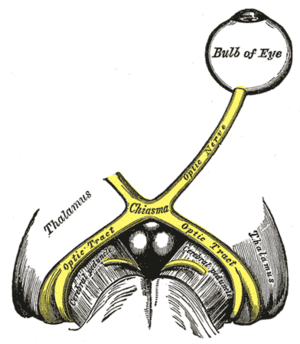Septo-optic dysplasia
Septo-optic dysplasia (SOD), is a rare congenital malformation syndrome featuring underdevelopment of the optic nerve, pituitary gland dysfunction, and absence of the septum pellucidum (a midline part of the brain). Two of these features need to be present for a clinical diagnosis — only 30% of patients have all three.[3] De Morsier first recognized the relation of a rudimentary or absent septum pellucidum with hypoplasia of the optic nerves and chiasm in 1956.[4]
| Septo-optic dysplasia | |
|---|---|
| Other names | de Morsier syndrome[1][2] |
 | |
| The optic nerve is underdeveloped in this condition | |
| Specialty | Ophthalmology |
Neuroradiologically, intracranial malformations associated with septo-optic dysplasia include agenesis of the septum pellucidum, schizencephaly, and lobar holoprosencephaly.
Presentation
Optic nerve
The optic nerve hypoplasia is generally manifested by nystagmus (involuntary eye movements, often side-to-side) and a smaller-than-usual optic disc. The degree of visual impairment is variable, and ranges from normal vision to complete blindness. When nystagmus develops, it typically appears by 1–8 months of age, and usually indicates that there will be a significant degree of visual impairment, but the severity is difficult to predict in infancy. Although there are many measures to compensate for visual impairment, there are few treatments available to induce normal optic nerve function.[5]
Pituitary
The degree of pituitary deficiency is also variable, and ranges from normal function, to deficiency of both anterior and posterior hormones. It is often unclear if the hypopituitarism is due to a primary pituitary dysfunction or is secondary to a hypothalamic dysfunction. Hypopituitarism in this syndrome is most often manifested by growth hormone deficiency. If severe, it can lead to diagnosis in the first days of life by causing hypoglycemia, jaundice, and micropenis (if a boy). The cause of the jaundice is unknown, and an unusual aspect of it (compared to most neonatal jaundice) is that it can be largely a conjugated (direct) hyperbilirubinemia suggestive of obstructive liver disease. It typically resolves over several weeks once hormone replacement is begun. All of the pituitary hormones can be replaced, and this is the treatment for deficiencies. Septo-optic dysplasia is one of the most common forms of congenital growth hormone deficiency.
Septum pellucidum
The brain effects are also variable. Seizures sometimes occur. Prediction of intellectual outcome in infancy is difficult. Various types of early intervention or equivalent programs can help a child reach full developmental potential.
Hydranencephaly
Hydranencephaly or lack of formation of brain can be found in extreme variants.[6]
Variability
Septo-optic dysplasia is a highly variable disorder. It is rare for siblings to present with identical features of the septo-optic dysplasia spectrum. Many patients present with additional developmental defects outside the septo-optic dysplasia triad. In particular digital defects are common.
Causes
Septo-optic dysplasia is a developmental disorder resulting from a defect of normal embryological development. There is no single cause of septo-optic dysplasia. Septo-optic dysplasia has been linked to young maternal age.[7]
Genetic
Rare familial recurrence has been reported, suggesting at least one genetic form (HESX1).[8] In addition to HESX1, mutations in OTX2, SOX2 and PAX6 have been implicated in de Morsier syndrome,[9] but in most cases SOD is a sporadic birth defect of unknown cause and does not recur with subsequent pregnancies.
Diagnosis
MRI will help with the diagnosis of structural abnormality of the brain. Genetic testing may also be pursued.
Treatment
References
- synd/2548 at Who Named It?
- G. de Morsier. Études sur les dysraphies, crânioencéphaliques. III. Agénésie du septum palludicum avec malformation du tractus optique. La dysplasie septo-optique. Schweizer Archiv für Neurologie und Psychiatrie, Zurich, 1956, 77: 267-292.
- Gleason, CA; Devascar, S (5 October 2011). "Congenital malformations of the Central Nervous System". Avery's Diseases of the Newborn (9 ed.). Saunders. p. 857. ISBN 978-1437701340.
- Daroff, Robert B.; Jankovic, Joseph; Mazziotta, John C.; Pomeroy, Scott L. (2015-10-25). Bradley's neurology in clinical practice. Daroff, Robert B.,, Jankovic, Joseph,, Mazziotta, John C.,, Pomeroy, Scott Loren,, Bradley, W. G. (Walter George) (Seventh ed.). London. ISBN 9780323339162. OCLC 932031625.
- NBC News
- Stehr, K; Mayer, U; Pfeiffer, RA; Reif, R (April 1985). "Extreme variant of septo-optic dysplasia". Ophthalmic Paediatrics and Genetics. 5 (3): 159–64. doi:10.3109/13816818509006129. PMID 3934619.
- McNay DE, Turton JP, Kelberman D, et al. (2006). "HESX1 mutations are an uncommon cause of septo-optic dysplasia and hypopituitarism". J Clin Endocrinol Metab. 92 (2): 691–7. doi:10.1210/jc.2006-1609. PMID 17148560.
- Dattani MT, Martinez-Barbera JP, Thomas PQ, et al. (1998). "Mutations in the homeobox gene HESX1/Hesx1 associated with septo-optic dysplasia in human and mouse". Nat. Genet. 19 (2): 125–33. doi:10.1038/477. PMID 9620767.
- "OMIM". Genetics Home Reference - Septo-Optic Dysplasia. Retrieved 5 February 2015.
- Jerome F. Strauss and Robert L. Barbieri (eds), "Yen and Jaffe's reproductive endocrinology; physiology, pathophysiology, and clinical management", 6th ed, 2009, p. 421.
- Dominguez, R; Aguirre Vila-Coro, A; Slopis, JM; Bohan, TP (June 1991). "Brain and ocular abnormalities in infants with in utero exposure to cocaine and other street drugs". American Journal of Diseases of Children. 145 (6): 688–95. doi:10.1001/archpedi.1991.02160060106030. PMID 1709777.
External links
| Classification |
|---|